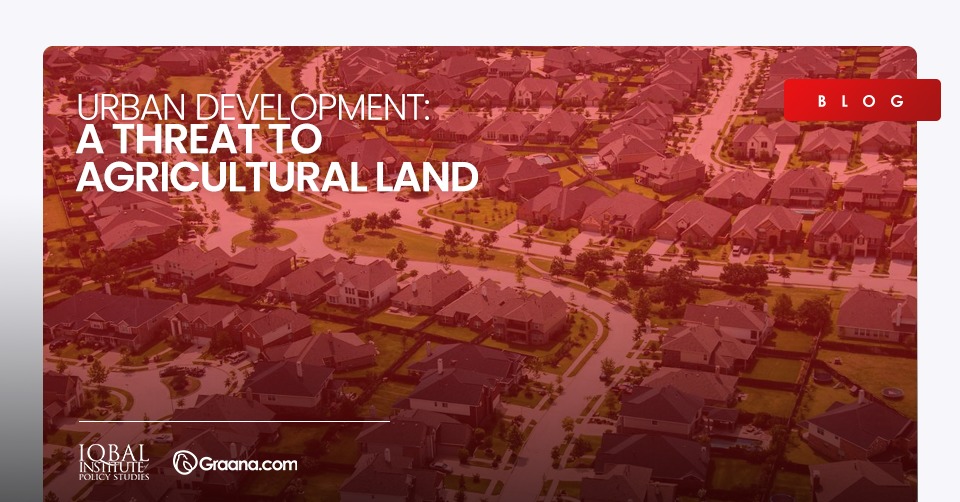Pakistan is listed amongst the top 10 countries with the highest GDP in agriculture. The agriculture sector of Pakistan plays a vital role in our economy as it is the second largest sector, accounting for over 21 per cent of the total GDP.
Pakistan is the main exporter of rice, cotton, sugarcane, corn, etc.; in fact, the agricultural sector employs more than 40 per cent of the nation’s workforce, therefore, being one of the key drivers of the country’s economic growth.
Recently, the caretaker minister for Agriculture and Livestock, Mr Abdul Haleem Qasuria, directed the relevant officials to take the necessary steps at the right time to protect the agricultural land from being used to develop housing societies infrastructures.
Graana.com in collaboration with the Iqbal Institute of Policy Studies discusses the various dimensions of urban development and the threats it poses to agricultural land development.
Types of Agricultural Land
There are three types of different agricultural land areas such as:
Arable
In this type of land, crops such as cereals, temporary meadows for mowing or pasture, land under market or kitchen gardens, and land temporarily fallow.
Permanent CropLand
Permanent cropland is cultivated with crops that occupy the land longer and need not be replanted after harvesting. This type of area can be used for vineyards and orchards.
Permanent Grassland
This type of land is an extensive kind of agricultural land use, which means that it is not ploughed, and even if it is, it’s done after every few years, but commonly, a threshold of 5 years is applied.
Effect of Urban Development on Agricultural Land
The majority of the agricultural land will be found outside of the main cities, in rural areas, therefore, making that land comparatively cheaper than the land available in cities, which makes that land a great target for investors to purchase and use for constructing mega projects such as housing societies, etc.
Now, one may ask, why do the landowners sell their land, well the answer is quite simple. One, money, and two, pressure from the purchasing authority (mafia/land grabbers). Other than these factors, the government sets crop prices too low that sometimes, to make ends meet, the farmers and landowners must sell the land.
If this trend continues, of selling the land, then there will be little to no crops left to feed the locals, let alone export, or if they target exporting, the locals will suffer. It is vital to save the land on which we grow crops; it is necessary for Pakistan’s survival and the overall economy.
GDP From Agriculture in Pakistan averaged 2518887.38 million PKR from 2006 until 2021, reaching an all-time high of 8791447.00 million PKR in 2021. About 40 per cent of Pakistan’s total land area is arable land, of which approximately 90 per cent is located in the Indus River plain of Punjab and Sindh provinces.
But suppose this “land selling” trend or constructing projects continues on land meant for agriculture. In that case, Pakistan’s economy will face, if not a massive blow considering that this industry holds up a great percentage of our GDP. At the same time, they also have over 40 per cent of the nation’s workforce (USAID, 2020).
Mr Abdul Haleem Qasuria issued the directives in a meeting regarding this topic and also expressed how illegal construction over agricultural land will hurt the economy as agriculture has an important role in strengthening the overall economy; therefore, housing societies and other such projects shall not be developed on agricultural lands.
He also stated that Pakistan is an agricultural country, and this sector is vital for Pakistan. According to an estimate, around 70 per cent of the people depend on agriculture. Without further planning, construction on such land will cause massive problems for the nation in the future. (Bureau Report, 2023)
An initiative has been taken by the government of Pakistan which tends to improve the agricultural sector in the next five years; they have introduced “Prime Minister’s Agriculture Emergency Programme”, which aims to increase agricultural productivity, while also creating value and reducing the dependence on imports to not only have a sustainable economy but do not rely on imports, and improve the lives of the farming community as they have been negated in the past. (Pakistan, 2020)
The Way Forward
Mapping is a simple visual way of seeing this. By mapping, the developers will better understand where they can construct and what is prohibited. With the help of this feature and enabling it online, one can hop online and verify the land while also seeing its properties, such as what kind of land it is and what type of construction can be done on it.
Other than this, the government must closely monitor such activities as they are blindsided now; they do not know what is happening unless brought to their attention. Therefore, they need to conduct regular surveys to ensure that everything is up to the mark and everything is in order.
If not done, then there is a chance that these lands, which were meant for agricultural purposes, will be utilised for development and if there is a domino effect to this, then there is no denying that the economy will further collapse shortly.
Conclusion
Pakistan is an agricultural country, and there is no doubt that if we don’t do anything to protect this industry, then we will also be amongst the ones suffering; we need to protect the agricultural land as if it is used for other purposes such as development, the repercussions will have to be faced by every individual considering we will be dependent on import for the sake of daily essentials.
The initiatives taken by the government and Mr Abdul Haleem have been appreciated seeing as how they are working towards the betterment of Pakistan; not only that, but due to their efforts, they have created more opportunities for farmers and given them a chance to improve their lives and standards further, this alone is a considerable factor seeing as if a farmer is being well paid.
Their needs are being met; they can afford education for their children, which can later benefit Pakistan. Our literacy rate will improve, our poverty rate will decrease, we will rely less on imports and can start exporting larger quantities, and the overall economy (GDP) will improve.




